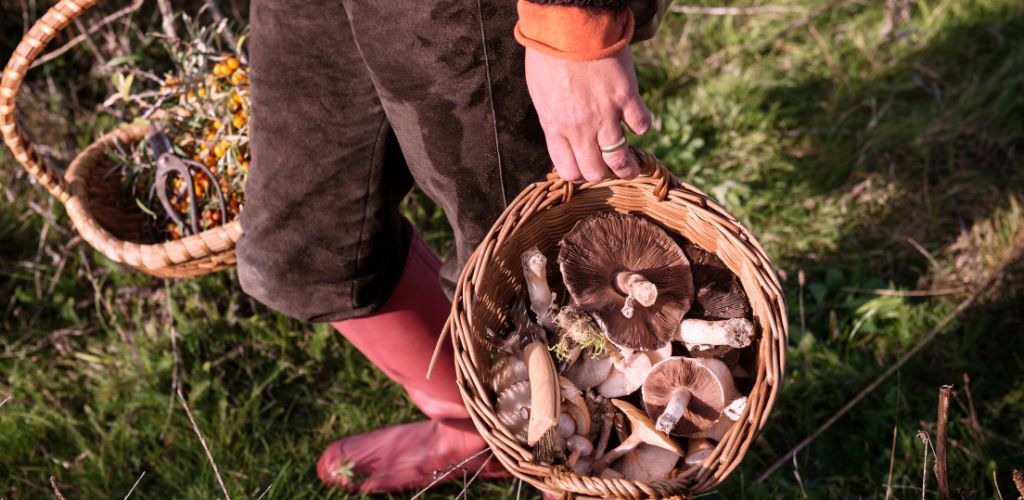Posted on August 31, 2023

Once you have gathered some basic knowledge on seasonality and inspiration on what to do with your haul, foraging can be a hugely rewarding way to spend a walk. Not only will it give your daily constitutional a sense of purpose, it’s a great activity to get kids outdoors and a brilliant, sustainable (packaging free!) food source.
Each season brings its own delights, right now (August) hedgerows are heaving with blackberries and elderberries – both great ‘starters’ for foraging novices (think syrups, ice creams and crumbles), before Autumn gets into full swing when sloes, hawthorn berries, rosehips and sweet chestnuts are bountiful.
Before you head out, hunter gatherer style, it’s worth learning the basics from trained, experienced experts on a guided course, or walk. This week we have a round-up of the best foraging courses in The Cotswolds, as well as some ‘foraging etiquette’ tips to bear in mind before your first trip…
6 foraging courses in The Cotswolds
Cerney House Gardens foraging
There are September courses available at Cerney House Gardens, with entry to the beautiful Victorian walled gardens and ancient woodland included as part of the fee. The guided walk at North Cerney (just north of Cirencester) covers all the foragings laws and safety best practices before you start, plus valuable training on how to tell edible species apart from poisonous lookalikes. There’s wild food recipes and a chance to sample foraged produce – from pestos to jams, cordials and soups.
Wild Food UK
With courses running through Autumn, the Wild Food UK foraging walk is based on the Bathurst Estate near Cirencester, offering a mixture of open grassland and woodland, with year round wild food foraging opportunities. Over a drink at the 18th century Tunnel House Inn, foragers will be given a briefing on the ‘foragers’ code’, as well as valuable information on the Countryside Act. Then it’s off on a 2.5 hour walk around the estate, learning to identify edible (and poisonous!) plants, flowers, fruits and mushrooms, with homemade, seasonal refreshments en route, such as elderflower champagne and fruit leathers. The course culminates back at the inn for a wild food lunch to celebrate the fruits of your labours.
Thyme Cookery School
Thyme’s Cookery School run a range of expert-led classes, both ‘in the field’ and at their beautifully appointed Cookery School. Learn how to master cooking seasonal wild fruit and veg in one of their classes based at the ‘Thyme Village’ – a retreat all of its own, including spa, hotel, cottages and restaurant.
Daylesford Organic
The Cotswolds foodie Mecca, Daylesford Organic offer monthly 'Wild and Foraged' day courses at their Cookery School in Stow-on-Wold. Spend the day exploring the estate on a guided foraging walk where you will gather the ingredients you need for a practical cookery session and it's not just berries and nuts - the estate is home to many game birds and crayfish too. Back at the Cookery School your tutor will demonstrate menu ideas including recipes for crayfish and rabbit risotto, blackberry fool and nettle tart.
Rob Gould, Cotswold Forager
With over 20 years of experience, Rob Gould offers two different courses running multiple times a month. The first is a walk where you’ll learn what wild edibles can be found in the surroundings the basics of foraging etiquette, laws and what recipes you can try at home with the foraged goodies you find on your walk. The second course are run at Hart's Barn Cookery School, where you’ll first forage in the local woodlands and orchards before heading back to the school to make drinks - think infused teas and syrups - and meals - including breads and pastas - from all that you’ve found.
Notgrove Foraging
Start the day at the gorgeous Notgrove Estate where you’ll learn the basic run down of the foraging code and countryside act. You’ll then be heading into the surrounding countryside to enjoy homemade refreshments while foraging away. Then head back and make a delicious lunch using what you’ve collected. Once the course is complete, you’ll be emailed a run down of what you went through including recipes you might’ve tried and others you missed out on and can try from home.
Ready to head out alone?
Once you’ve picked up the basics, grab a basket and head out with new eyes, once you know what you’re looking for you’ll soon start to notice the produce filling our fields and hedges, ready to be enjoyed. Before you start picking however, here are some great ‘rules of the countryside’ to consider:
Foraging etiquette and tips:
Probably the most basic of rules – ensure the land that you are foraging on is a public right of way and not privately owned.
A general foraging rule is to ‘only take what you need’, be mindful of leaving enough for wildlife as we head into the leaner winter months, as well as other foragers to gather too.
As you forage think about any permanent damage you may be doing to both the plant itself, or the surrounding area. Avoid trampling other flora underfoot, or removing large portions of a plant; pick carefully and tread lightly.
Similarly, be careful not to disturb any wildlife habitats as you forage.
Be aware that Britain’s wild plants are all protected under the Wildlife and Countryside Act (1981), which makes it illegal to dig up or remove a plant. Different plant species are protected in different geographical areas, so it is worth researching your local foraging spots before heading out.
Finally, do your research! Ideally spend some time learning from an expert before foraging yourself, or at the least read up (preferably with photographic references) on the species you are looking to forage. If in doubt – don’t pick!